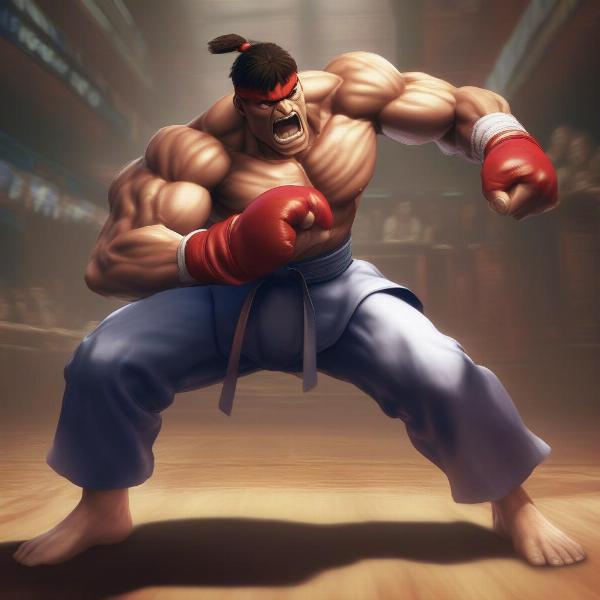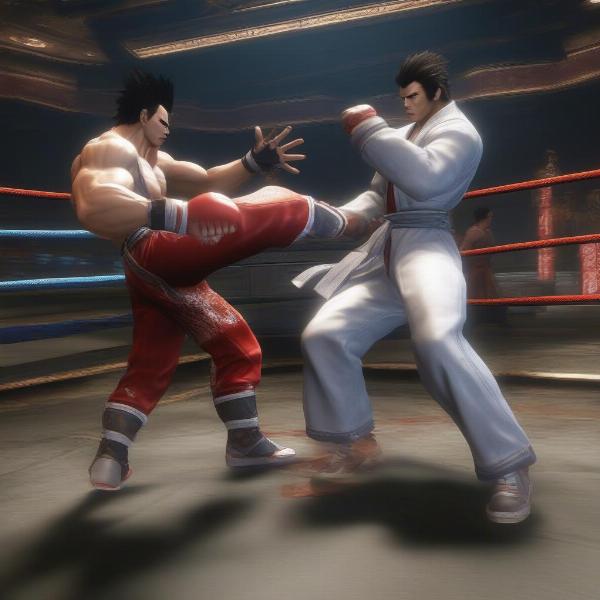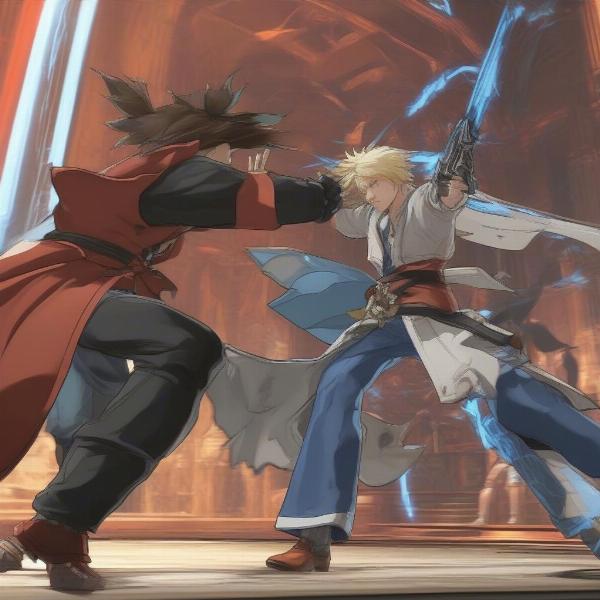Oki refers to the pressure and mix-up options a player creates after knocking down their opponent in a fighting game. It’s a crucial element of offensive play, dictating the pace and momentum of the match. Understanding oki is essential for any fighting game player looking to improve their game.
Decoding the Mystery: Oki Explained
Oki, derived from the Japanese word “okizeme” (起き攻め), literally translates to “wake-up attack.” However, in the fighting game community, it encompasses more than just the initial attack. Oki involves the entire pressure sequence after a knockdown, including the potential mix-ups, frame traps, and left/right guesses the offensive player forces on their recovering opponent. Mastering oki can mean the difference between securing a round and giving your opponent a chance to reset.
Why is Oki Important?
Oki is a cornerstone of offensive strategy in fighting games. It allows you to maintain pressure, potentially leading to significant damage or even a round win. Effective oki can stifle your opponent’s comeback attempts, forcing them to play defensively and limiting their options.
The Core Components of Oki
Oki isn’t just about hitting your opponent as they get up. It’s a multi-layered system involving:
- Knockdown Setup: The initial action that leads to the knockdown, such as a sweep, launcher, or overhead attack.
- Wake-up Options: The choices available to the defender as they recover from the knockdown, such as blocking, teching (a defensive maneuver), or using a wake-up attack.
- Offensive Mix-ups: The attacker’s options to pressure the defender, including high/low attacks, overhead strikes, cross-ups (attacks that hit behind the opponent), and frame traps (attacks spaced to catch delayed wake-up options).
- Mind Games: Oki is heavily reliant on psychological warfare. By conditioning your opponent to expect certain attacks, you can open them up to more damaging options.
 Oki Setup Example in Street Fighter
Oki Setup Example in Street Fighter
Mastering the Art of Oki: Tips and Tricks
Developing strong oki requires practice and an understanding of your character’s tools. Here are some tips to improve your oki game:
- Know Your Character: Understand your character’s fastest attacks, overheads, and low attacks. These are your primary oki tools.
- Learn Frame Data: Knowing the frame data for your character’s moves and your opponent’s wake-up options is crucial for creating effective mix-ups and frame traps.
- Condition Your Opponent: Repeatedly using the same oki setup can lull your opponent into a false sense of security, making them vulnerable to a different approach.
- Adapt and Overcome: Don’t be afraid to switch up your oki strategies. If your opponent is consistently blocking your overhead, try a low attack or a throw.
 Oki Mix-up Options in Tekken
Oki Mix-up Options in Tekken
Advanced Oki Concepts: Meatys and More
As you progress in your fighting game journey, you’ll encounter more advanced oki concepts. “Meaty” attacks, for instance, are attacks timed to hit the opponent on the first active frame of their wake-up. This can severely limit their defensive options.
Reading Your Opponent: The Key to Oki Success
Oki is not just about executing pre-planned sequences. It’s about reading your opponent’s reactions and adapting accordingly. Observe their wake-up habits – do they tend to block high, low, or tech? Use this information to your advantage.
“Predicting your opponent’s wake-up option is half the battle,” says renowned fighting game player, Alex “CaliPower” Valle. “Effective oki is all about applying pressure and forcing your opponent to make mistakes.”
 Oki Mind Games Example in Guilty Gear
Oki Mind Games Example in Guilty Gear
Oki Across Different Fighting Games
While the core principles of oki remain consistent, its application varies across different fighting games. Games with faster movement and shorter recovery times, like Marvel vs. Capcom, tend to have more intricate oki setups. In contrast, slower-paced games like Street Fighter emphasize more on fundamental oki principles.
Training Your Oki: Practice Makes Perfect
The best way to improve your oki is to practice it consistently. Spend time in training mode, experimenting with different setups and mix-ups. Record your opponent’s gameplay and analyze their wake-up habits. With dedication and practice, you can transform your oki from a weakness into a powerful weapon.
The Impact of Oki on Competitive Play
Oki plays a significant role in high-level fighting game competition. Professional players utilize intricate oki setups to control the pace of the match and dominate their opponents. Understanding and implementing effective oki strategies is essential for anyone aspiring to compete at a higher level.
In conclusion, oki is a fundamental aspect of fighting games, allowing offensive players to maintain pressure and control the flow of the match after a knockdown. By understanding the core components of oki and practicing different setups, you can significantly improve your gameplay and dominate your opponents. So, get out there and start pressuring those wake-ups!
FAQ
- What does “oki” mean in fighting games? Oki is short for okizeme, Japanese for “wake-up attack,” referring to offensive pressure after a knockdown.
- Why is oki important? Oki allows you to maintain offensive pressure and control the match’s momentum after knocking down your opponent.
- How can I improve my oki? Practice different setups, learn frame data, and adapt to your opponent’s reactions.
- What are “meaty” attacks? Meaty attacks hit the opponent on the first active frame of their wake-up, limiting their options.
- Does oki work differently in different fighting games? While core principles are similar, application varies based on game speed and mechanics.
- How do I practice oki? Utilize training mode to experiment with setups and record matches to analyze opponent habits.
- What’s the most important thing to remember about oki? Oki is about reading your opponent and adapting your pressure accordingly, not just pre-planned sequences.

